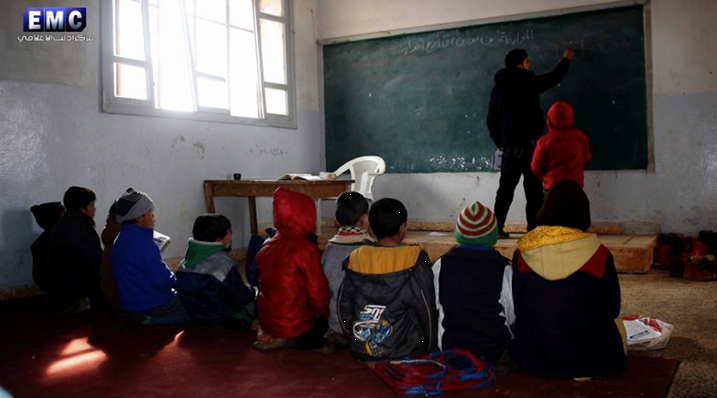Siria/Mayo de 2017/Fuente: Syria:direct
Resumen: El gobierno sirio y sus aliados llevaron a cabo «24 ataques» en instalaciones médicas sólo en abril, «matando a 10 trabajadores de salud e hiriendo a 16», anunció la Sociedad Médica Americana Siria en un comunicado reciente. Una rutina familiar sigue a cada uno de estos ataques: Defensa Civil primera raza de rescate para rescatar a los supervivientes, el personal del hospital se apresuran a evacuar a los pacientes y rescatar equipos médicos costosos y funcionarios médicos locales comienzan a planificar el proceso de reconstrucción. Pero la reconstrucción es costosa, y la financiación es escasa, a menudo dejando a los consejos locales con escasez de dinero en territorio de oposición, y al noroeste de la provincia de Idlib en particular, incapaces de restaurar otras instalaciones públicas dañadas después de un ataque aéreo.
The Syrian government and its allies carried out “24 attacks” on medical facilities in April alone, “killing 10 health workers and injuring 16,” the Syrian American Medical Society announced in a recent statement.
A familiar routine follows each of these attacks: Civil Defense first responders race to rescue survivors, hospital staff scramble to evacuate patients and salvage expensive medical equipment and local medical officials begin planning the reconstruction process.
But rebuilding is expensive, and funding is scarce, often leaving cash-strapped local councils in opposition territory, and northwest Idlib province in particular, unable to restore other damaged public facilities in the wake of an airstrike.
As a result of “continuous bombing,” Jamal a-Shahoud, Idlib province’s director of education, says more than 350 schools in Idlib are closed. Another 400 more are “40 to 50 percent destroyed;” still functioning but unable to be repaired. Syria’s northern Idlib province is the largest remaining bastion of rebel resistance and the focus of a months-long Russian and regime bombing campaign.
“We simply don’t have the financial resources for reconstruction,” the opposition official tells Syria Direct’s Bahira al-Zarier. “Hospitals take priority in light of the war.”
Q: When a hospital is bombed, it is more often than not rebuilt in a new facility. Why aren’t Idlib’s schools treated the same way?
We simply don’t have the financial resources for reconstruction. As you know, funding is given out by humanitarian organizations, and hospitals take priority in light of the war.
We have 1,446 schools in Idlib, while there are fewer than 50 hospitals in the province.
Q: Which costs are the Idlib Education Directorate able to defray in the aftermath of a school bombing?
Rebuilding efforts are limited to the essentials such as removing rubble. Otherwise, we’ll go on using the classrooms that were not bombed. We aren’t able to buy new supplies after a bombing.
We really do struggle financially after a bombing. Already, we don’t have the money to pay the wages of all of our teachers and staff; 50 percent of the educational staff work either for a small stipend or a food ration.
Q: The opposition’s interim government isn’t providing any funding?
They aren’t paying for salaries, not even for the provincial directors of education. Our organization—along with other directorates—hasreached out to major donor organizations to try to secure grants for monthly salaries, but we’ve only reached half of our requested amount.
Q: Describe what measures you do to take to keep schools safe amidst all of the bombardment.
The Education Directorate has a two-part plan in place when it comes to dealing with schools that could be targeted. First, we try to lessen the amount of time that students spend in the school by eliminating non-essential courses such as art and sports. Schools are in session for just four hours a day; it’s not enough, but students and teachers are all very cautious of any attack that may take place.
Second, we make sure that schools are located in either basements or shelters.
In the event that a school is bombed, students and teachers do not return until the attack ends. Afterwards, we try to restore whatever can be salvaged and bring the school back into operation. If there is a shortage in the number of rooms, then we’ll hold two sessions of schools hours. Essentially, one building serves as two schools.
It’s true that classes are periodically suspended, and as such, we’re adding an additional week of make-up classes. We also have a summer-school plan in place for children in elementary school.
Q: You mentioned that there are nearly 1,500 schools in Idlib. Are all of them currently active?
There are 1,080 schools that are operating in the province in varying degrees. I say “varying degrees” because we’ll cancel school if there is a bombing in the city, but we won’t close schools across the whole province. Of these, 400 schools are between 40 and 50 percent destroyed. There are nine schools that are operating out of private homes, in addition to schools based out of tents and caravans in the camps. Finally, there are 357 schools that are entirely destroyed.
Q: Can bombing kill education?
I want to be fully transparent here: Education has been severely damaged as a result of the continuous bombing of rebel-held areas. Parents are afraid to send their children to school. But despite all of these circumstances, more than 1,050 schools are still operating. This sends a powerful message to the world that we are a people who deserve life, who deserve respect. We will move beyond fear, danger and hunger to demand education.
Yes, the bombings are a major obstacle. But when school is in session, we are prepared to make the classroom better than it ever was before.
Fuente: http://syriadirect.org/news/the-triage-of-reconstruction-in-syria%E2%80%99s-north-and-the-schools-left-behind/





 Users Today : 93
Users Today : 93 Total Users : 35459559
Total Users : 35459559 Views Today : 144
Views Today : 144 Total views : 3417902
Total views : 3417902